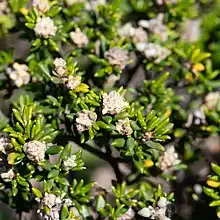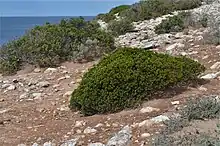| Spyridium phylicoides | |
|---|---|
 | |
| Near the Cape Spencer Lighthouse | |
| Scientific classification | |
| Kingdom: | Plantae |
| Clade: | Tracheophytes |
| Clade: | Angiosperms |
| Clade: | Eudicots |
| Clade: | Rosids |
| Order: | Rosales |
| Family: | Rhamnaceae |
| Genus: | Spyridium |
| Species: | S. phylicoides |
| Binomial name | |
| Spyridium phylicoides | |
| Synonyms[1] | |
| |

Spyridium phylicoides, commonly known as narrow-leaved spyridium,[2] is a species of flowering plant in the family Rhamnaceae and is endemic to South Australia. It is a low shrub with rigid, linear or lance-shaped leaves, and heads of woolly-hairy flowers.
Description
Spyridium phylicoides is a low shrub with rigid, linear to lance-shaped leaves 5–14 mm (0.20–0.55 in) long and 1–3 mm (0.039–0.118 in) wide with the edges rolled under. The upper surface of the leaves is glabrous and the lower surface woolly-hairy, but often hidden by the inrolled edges of the upper surface. The heads of "flowers" are more or less sessile, 5–7 mm (0.20–0.28 in) in diameter and woolly-hairy with 2 to 5 floral leaves shorter but broader than the stem leaves. Flowering occurs from September to December and the fruit is an oval to more or less spherical capsule 2–3 mm (0.079–0.118 in) long.[2]
Taxonomy
This species was first formally described in 1858 by Siegfried Reissek in the journal Linnaea from specimens collected by Johann Wilhelmi, near Lake Hamilton in 1855.[3][4] The specific epithet (phylicoides) means "Phylica-like".[5]
Distribution
Spyridium phylicoides occurs in the Nullarbor, Eyre Peninsula, Murray, Yorke Peninsula, Southern Lofty, Kangaroo Island and South Eastern botanical regions of south-eastern South Australia.[2]
References
- 1 2 "Spyridium phylicoides". Australian Plant Census. Retrieved 22 October 2022.
- 1 2 3 "Spyridium phylicoides". State Herbarium of South Australia. Retrieved 22 October 2022.
- ↑ "Spyridium phylicoides". Australian Plant Name Index. Retrieved 22 October 2022.
- ↑ Reissek, Siegfried (1858). "Plantae Muellerianae Australasicae - Celastrineae, Rhamneae". Linnaea: ein Journal für die Botanik in ihrem ganzen Umfange, oder Beiträge zur Pflanzenkunde. 29 (3): 286–287. Retrieved 22 October 2022.
- ↑ Sharr, Francis Aubi; George, Alex (2019). Western Australian Plant Names and Their Meanings (3rd ed.). Kardinya, WA: Four Gables Press. p. 276. ISBN 9780958034180.